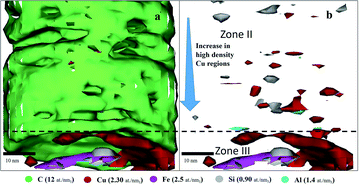Atom probe tomography and transmission electron microscopy: a powerful combination to characterize the speciation and distribution of Cu in organic matter†
Abstract
The large surface areas in porous organic matter (OM) and on the surface of altered minerals control the sequestration of metal(loid)s in contaminated soils and sediments. This study explores the sequestration of Cu by OM in surficial forest soil in close proximity to the Horne smelter, Rouyn-Noranda, Quebec, Canada. The organic-rich soils have elevated concentrations of Cu (Cu = 〈0.75〉 wt%) but lack associations between organic matter (OM) and Cu-sulfides, commonly observed in organic-rich Cu-contaminated soils. This provides a unique opportunity to study the sequestration of Cu by OM in a sulfur-depleted environment using a combination of scanning electron microscopy (SEM), transmission electron microscopy (TEM) and atom probe tomography (APT). In two examined OM particles, Cu is predominantly sequestered as (I) nano- to micrometer-size Cu-bearing spinels, (II) as cuprite (Cu2O) nanoparticles or (III) finely dispersed Cu in association with clusters of magnetite (Fe3O4) nanoparticles embedded in amorphous silica-rich pockets and (IV) in the OM matrix. The occurrence of euhedral crystals and nanoparticles in the single-digit range within the OM matrix indicate that the majority of the nanoparticles formed in situ within the OM particles. A model is developed which proposes that the sequestration of Cu in OM is promoted by (I) the partial mineralization of the OM matrix by amorphous silica; (II) the nucleation of magnetite nanoparticles on highly reactive silanol groups; (III) the diffusion of Cu within mineralized and altered areas of the OM; (IV) the availability of Cu-bearing species, which in turn is controlled by the hydrodynamic properties of the pore channels; (V) the formation of precursors and nucleation of Cu-bearing nanoparticles. This study shows that the combination of SEM, TEM and APT provides new insights into the sequestration of metal contaminants by OM at various scales ranging from the single-digit nano- to micrometer scale.

- This article is part of the themed collection: Contaminant remediation and fate


 Please wait while we load your content...
Please wait while we load your content...